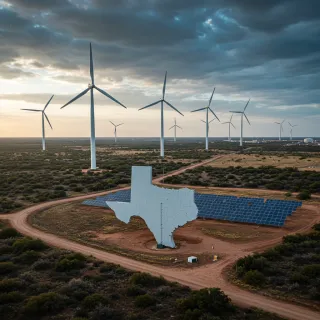THINKING ABOUT GOING SOLAR?
LET SOLAR CONNECTION INITIAITIVE ANSWER YOUR QUESTIONS AND SEE IF SOLAR IS RIGHT FOR YOU.
// GOING GREEN
The Solar Process
01...

Fill out the a quick form with your basic contact information.
02...

Speak with a Solar Expert about any and all questions you have about solar energy.
03...

Your representative will generate a cost and savings estimate custom tailored to your home.
04...

If Solar Energy is a good fit for your home, your representative will work with you to initiate the process.
WHY ARE PEOPLE GOING SOLAR?

COST CONTROL
By having a choice where you get your power, you can avoid annual rate increases and have more control of your energy cost.

HOME UPGRADE
List your home as an "energy efficient home" helping it to sell faster or for a premium.

SAVE MONEY
Solar technology has come a long way! In most states, solar can be cheaper than your energy provider.

ENVIROMENT
Solar comes from an endless renewable source while utility companies source energy from sources like plants that burn coal.
WHAT YOU WILL LEARN THROUGH SOLAR CONNECTION INITIATIVE
How many solar panels are needed to power your home
How many square feet of suitable roof space is required
How many solar panels will fit on your roof and where they will go
How much energy the solar panels on your roof will produce
Your likely payback period for your home solar system
How much solar panels will cost for your home based on the average solar system cost in your area

THE GRID
Aside from being very inefficient, this way of power delivery is terrible for the environment, and to top it off, it's VERY expensive. Rates will continue to rise unless we make a change.
Credibility factor lorem ipsum
Authority stats and other lorem ipsum
Results and experience lorem ipsum
The Smart Way
Solar is simple, efficient, better for the planet, cheaper than you pay and often times you pay nothing up front to go solar. Plus, there is no more annual rate increases to work into your family budget. Why pay more to power your home when there is a better option?
Solar Panels - Convert sunlight into direct current electricity
Inverter - Converts direct current electricity into alternating current electricity your home can use.
Net Meter - Rolls backwards as the solar produces more power than is being used.


THE POWER OF NET METERING
Sell Energy Back To The Grid - Once solar is installed on your home, you are able to sell energy back to the utility company when you generate more than your home requires. During this time the meter will spin backwards showing a negative consumption of energy.
Earn Energy Credits To Offset Energy Use - As energy is sold to the company, you are able to earn energy credits that can be used during low solar production periods or peak time of the year. This allows you, the home owner to have a smaller system and achieve a 100% offset with a lower solar payment.

Texas Solar Boom: How the Lone Star State is Leading in Renewable Energy
Discover the rapid growth and innovative spirit driving Texas' solar industry. From vast desert solar farms to rooftop installations, the Lone Star State is harnessing the power of the sun to fuel its... ...more
Solar
May 20, 2025•3 min read
questions about solar?
Frequently Asked Questions
Question 1: How do solar panels work?
Solar panels work by converting sunlight into electricity using photovoltaic (PV) cells. When sunlight hits these cells, it triggers the flow of electrons, generating direct current (DC) power. This electricity is then converted into usable alternating current (AC) by an inverter, allowing it to power your home. Any extra energy can be sent back to the grid or stored for later use.
Question 2: How much do solar panels cost?
The cost of a home solar panel system typically ranges from $15,000 to $25,000 before tax incentives. The final price depends on factors like the size of your system, the type of panels used, and your local installation rates. Federal and state solar incentives can significantly reduce the overall cost, making solar energy more affordable than ever.
Question 3: Are solar panels a good investment?
Yes, solar panels are a smart long-term investment. They lower your monthly electricity bills, increase your home’s resale value, and often pay for themselves within 7–10 years. With rising utility costs and generous solar incentives, switching to solar offers both environmental and financial benefits.
Question 4: Do solar panels still work on cloudy days?
Solar panels do generate electricity on cloudy days, just at a lower output. While direct sunlight produces the most energy, panels can still capture diffuse sunlight during overcast weather. Depending on panel efficiency and cloud density, production may drop to 10–25% of typical output.
Question 5: What is net metering?
Net metering is a billing system that credits you for the surplus solar energy your panels send to the utility grid. These credits offset your future energy use, helping you maximize savings. It allows you to "store" energy without needing a battery, making solar even more cost-effective.
Question 6: How long do solar panels last?
Most solar panels are built to last 25 to 30 years or more. Over time, they experience a gradual drop in efficiency—typically losing about 0.5% of output per year. With proper installation and minimal maintenance, your system can continue producing power well past its warranty period.
Question 7: What maintenance is required for solar panels?
Solar panels require very little upkeep. Occasional cleaning to remove dirt, dust, or leaves will help maintain peak performance. It’s also smart to have your system professionally inspected once a year to ensure everything is operating efficiently and safely.
Question 8: Can solar panels power my entire home?
Yes—if your solar system is sized correctly, it can generate enough electricity to meet 100% of your home's energy needs. Factors like your roof size, sun exposure, and daily energy usage will determine how much power your system can supply.
Question 9: What happens to excess electricity produced?
When your system generates more electricity than your home uses, that excess power is sent to the utility grid. Through net metering, you earn credits for this energy, which can be used to offset your electricity use when your panels aren't producing, such as at night.
Question 10: Should I replace my roof before going solar?
If your roof is nearing the end of its life (typically 15–20 years), it’s smart to replace it before installing solar panels. This avoids the cost and hassle of removing and reinstalling the system later. A solid, long-lasting roof ensures your solar investment is protected.
Question 11: Are there tax credits or incentives for solar?
Yes, solar energy systems qualify for federal and often state-level incentives. The Federal Solar Tax Credit (ITC) currently allows you to deduct 30% of your system’s cost from your federal taxes. Local utility rebates and property tax exemptions may also be available.
Question 12: How efficient are solar panels today?
Most residential solar panels today have an efficiency between 17% and 22%. This means they convert that percentage of sunlight into electricity. While this may seem low, higher efficiency panels require less roof space to produce the same amount of power, making them ideal for homes with limited roof area.
Question 13: Will solar panels damage my roof?
No, when installed by licensed professionals, solar panels won’t damage your roof. In fact, they can help protect the portions of the roof they cover from weather damage and UV exposure. A quality installation ensures long-term roof integrity.
Question 14: Can I install solar panels myself?
DIY solar installation is possible but not recommended unless you have electrical and permitting experience. Professional installers ensure your system meets all local codes, passes inspections, and qualifies for rebates and warranties. They also handle the paperwork for net metering and tax credits.
Question 15: How long does it take to install solar panels?
Once permits are approved, the physical installation usually takes 1 to 3 days. However, the full process—including site evaluation, permitting, utility approval, and inspection—can take 4 to 8 weeks from start to finish, depending on your location and utility company.
Question 16: Will solar panels increase my home’s value?
Yes. Homes with solar energy systems typically sell for more than comparable homes without solar. Buyers are drawn to the long-term energy savings and reduced utility bills, making solar panels a valuable upgrade.
Question 17: Do solar panels work during a power outage?
Standard grid-tied solar systems automatically shut off during outages for safety reasons. To keep your home powered during a blackout, you’ll need a solar battery backup or hybrid system that can operate independently of the grid.
Question 18: What’s better: leasing or buying solar panels?
Buying solar panels usually provides a higher return on investment and gives you access to tax incentives and rebates. Leasing requires little to no upfront cost, but the long-term savings are typically lower, and you may not benefit from available incentives.
Question 19: Can I add more solar panels later?
Yes, most systems are expandable. If your energy usage increases or you want to further reduce your utility bill, additional panels can often be added. It’s important to confirm compatibility with your existing inverter and system design.
Question 20: What are the environmental benefits of switching to solar energy?
Switching to solar energy significantly reduces your carbon footprint by decreasing reliance on fossil fuels. Solar panels generate clean, renewable power without emitting greenhouse gases or air pollutants. Over their lifetime, a residential solar system can offset tens of thousands of pounds of CO₂—equivalent to planting hundreds of trees or avoiding thousands of miles driven by a gas-powered car. By choosing solar, you contribute to cleaner air, water conservation, and a more sustainable planet for future generations.
Office: 1312 17TH ST UNIT 2460 DENVER, CO 80202
Call 940-353-7542
Email: solarconnectionsxi@gmail.com
Site: www.solarci.org
Solar Connection Initiative is a 501(c)3 tax-exempt organization and your donation is tax-deductible within the guidelines of U.S. law.
Tax ID #20241614228
QUICK LINKS:
TERMS OF SERVICE
PRIVACY POLICY
DISCLAIMER
